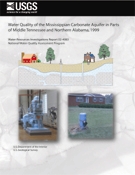

 |
Water Quality of the Mississippian Carbonate Aquifer in Parts of Middle Tennessee and Northern Alabama, 1999U.S. Geological Survey, Water-Resources Investigations Report
02-4083 This report is available as a pdf below |
Water-quality data for nitrate, fecal-indicator bacteria, pesticides, and volatile organic compounds collected in parts of Middle Tennessee and northern Alabama indicate that the Mississippian carbonate aquifer in these areas is susceptible to contamination from point and nonpoint sources. Thirty randomly located wells (predominantly domestic), two springs, and two additional public-supply wells were sampled in the summer of 1999 as part of the U.S. Geological Survey’s National Water-Quality Assessment (NAWQA) Program. These wells and springs were sampled to characterize the occurrence and distribution of the above constituents in this karst aquifer of Mississippian age and to determine the principal environmental factors related to their occurrence.
Nitrate and fecal indicator bacteria were frequently detected at the sampled sites. Nitrate exceeded the drinking-water maximum contaminant level of 10 milligrams per liter in two samples; the median concentration for all samples was about 1.5 milligrams per liter. Correlation of nitrate concentrations to the amount of cropland near a site and to pesticide detections indicates that fertilizer application is the predominant source of nitrogen to the aquifer. Fecal-indicator bacteria were present in samples from about 40 percent of the sites. The presence of fecal-indicator bacteria is weakly correlated to the depth to ground water but is not correlated to a specific land use near the sites.
Pesticides and pesticide breakdown products (metabolites) were detected at 74 percent of the sites sampled. Concentrations generally were less than 1 microgram per liter and no pesticide detections exceeded drinking-water maximum contaminant levels. The maximum total pesticide concentration measured was about 4 micrograms per liter. Intensity of pesticide use, proximity of sites to areas of pesticide application, and soil hydrologic group were the primary factors affecting the occurrence of pesticides.
Volatile organic compounds were detected at generally low concentrations at about 81 percent of the sites sampled. Concentrations of trichloroethylene, tetrachloroethylene, and 1,2-dichloropropane at three sites equalled or exceeded drinking-water maximum contaminant levels. The maximum concentration measured was 7.5 micrograms per liter of trichloroethylene. The presence of volatile organic compounds in the Mississippian carbonate aquifer was not related to hydrogeology, soil properties, or land use near the sites; although higher total volatile organic compound concentrations and greater numbers of compounds in samples generally were associated with a higher percentage of urban land use near a site. Chloroform was the most frequently detected compound, and correlation of low-level detections to the amount of wetlands near sites having these detections may indicate biogenic formation of chloroform.
The relation between land use and water quality was stronger for constituents that are contributed to the environment systematically (fertilizer and pesticide applications), than those contributed inadvertently (leaking septic tanks or chemical spills or leaks). Land use and soils characterized in circular buffer areas near sites sampled in this karst aquifer explained some of the variation in nitrate concentration and presence of pesticides. Use of land use and soil data with greater detail than the large scale data used in this analysis and buffer areas based on well capacities and ground-water withdrawals might strengthen this type of analysis.
| AccessibilityFOIAPrivacyPolicies and Notices | |
 |
|